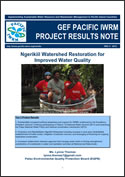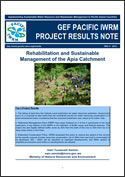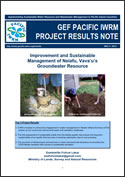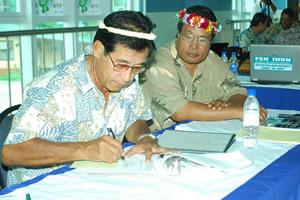for the Global Environment Facility Supported Project Entitled:
"Implementing Sustainable Water Resources and Wastewater Management in Pacific Island Countries"
The overall strategic results framework or project logframe for the GEF Pacific IWRM Project contains a number of indicators for project monitoring. Following project inception, these indicators were considered in detail by the Regional Technical Advisory Group (RTAG) of the project's Regional Steering Committee (RSC). The result of this work was a regionally agreed Project Monitoring and Evaluation Framework for use in tracking and measuring the impact of project in its key result areas. This webpage has been developed to ensure ease of access to project indicator sets and reporting templates by National IWRM Project Management Units, Demonstration Project Coordinating Committees, and APEX Water Bodies in Pacific Island Countries.
Summary Logframe | Full Logframe | RBM Overview | Project Monitoring and Evaluation Framework | Summary of Result Areas |
Pacific IWRM Results Notes - 2012 |
| National IWRM teams presented the following results notes to the Fourth Regional Steering Committee Meeting for the GEF Pacific IWRM Project on 31st July 2012. Each participating country reported on progress against 6 indicators of choice from their national indicator sets. Follow the links below to access these notes. |
 |
 |
 |
 |
 |
 |
| Fiji Islands |
F.S. Micronesia |
Nauru |
Niue |
Palau |
Marshall Islands |
 |
 |
 |
 |
 |
|
| Samoa |
Solomon Is. |
Tonga |
Tuvalu |
Vanuatu |
|
| |
NATIONAL PROJECT INDICATOR SETS |
 |
 |
 |
 |
 |
 |
 |
 |
 |
 |
 |
 |
|
Click Country Flag to Download Indicator Set for that Country
|
| |
NATIONAL PROJECT INDICATOR REPORTING TEMPLATES |
 |
 |
 |
 |
 |
 |
 |
 |
 |
 |
 |
 |
|
Click Country Flag to Download Indicator Reporting Template for that Country
|
| |
Component 1 | Component 2 | Component 3 | Component 4
|
COMPONENT 1: DEMONSTRATION, CAPTURE AND TRANSFER OF BEST PRACTICES IN IWRM AND WATER USE EFFICIENCY |
| The objective of this component includes practical demonstrations of IWRM and WUE focused on removing barriers to implementation at the community/local level and targeted towards national and regional level learning and application. It is anticipated that lessons learned from demonstrations of IWRM and water use efficiency approaches will be replicated and mainstreamed into existing cross-sectoral local, national and regional approaches to water management. Specific result areas of Component 1 include:
|
| |
COMPONENT 2: IWRM AND WUE REGIONAL INDICATOR FRAMEWORK |
 President Jurelang Zedkaia opening the Republic of the Marshal Islands' 1st National Water Summit in March 2011 President Jurelang Zedkaia opening the Republic of the Marshal Islands' 1st National Water Summit in March 2011
- 2.1: Process, Stress Reduction, Environmental and Socio-Economic Status, WUE, Catalytic, Governance, Proxy, and X-Cutting Regional Indicator Framework (RIF) established and in use
- 2.2: Participatory M&E adopted within Demonstration Projects [C1] and mainstreamed into national best practice
- 2.3: Improved institutional capacity for monitoring and support for action on findings across the region, including Pacific RAP progress for water investment planning
|
| |
COMPONENT 3: POLICY, LEGISLATIVE AND INSTITUTIONAL REFORM FOR IWRM AND WUE |
 President Emanuel Mori signing the Federated States of Micronesia's 1st Water and Sanitation Policy in March 2011 President Emanuel Mori signing the Federated States of Micronesia's 1st Water and Sanitation Policy in March 2011
- Output 3.1 National IWRM plans and WUE strategies developed and endorsed
- Output 3.2 Implementation of IWRM approaches agreed across national, community and regional organisations
- Output 3.3 Strengthened and sustainable APEX water bodies to catalyze implementation of national IWRM and WUE plans, including balanced gender membership
- Output 3.4 Awareness raised across civil society, governments, education systems and the private sector
- Output 3.5 Sustainability strategies developed focusing on institutional and technical interventions required for Demonstration scaling-up as part of National IWRM Plan development and implementation
|
| |
COMPONENT 4: REGIONAL AND NATIONAL CAPACITY BUILDING AND SUSTAINABILITY PROGRAMME FOR IWRM AND WUE, INCLUDING
KNOWLEDGE EXCHANGE AND LEARNING AND REPLICATION |
 Dr. Al Duda of the GEF Secretariat and members of the Pacific IWRM Project Network, July 2011 Dr. Al Duda of the GEF Secretariat and members of the Pacific IWRM Project Network, July 2011
- Output 4.1: National and regional skills upgraded in project management and monitoring including water champions and APEX bodies for both men and women
- Output 4.2: Active twinning programmes in place between countries facing similar water and environmental degradation problems
- Output 4.3: Effective knowledge management networking and information sharing inter and intra-regional
|
| |
|
| |
|












 President Jurelang Zedkaia opening the Republic of the Marshal Islands' 1st National Water Summit in March 2011
President Jurelang Zedkaia opening the Republic of the Marshal Islands' 1st National Water Summit in March 2011 President Emanuel Mori signing the Federated States of Micronesia's 1st Water and Sanitation Policy in March 2011
President Emanuel Mori signing the Federated States of Micronesia's 1st Water and Sanitation Policy in March 2011 Dr. Al Duda of the GEF Secretariat and members of the Pacific IWRM Project Network, July 2011
Dr. Al Duda of the GEF Secretariat and members of the Pacific IWRM Project Network, July 2011